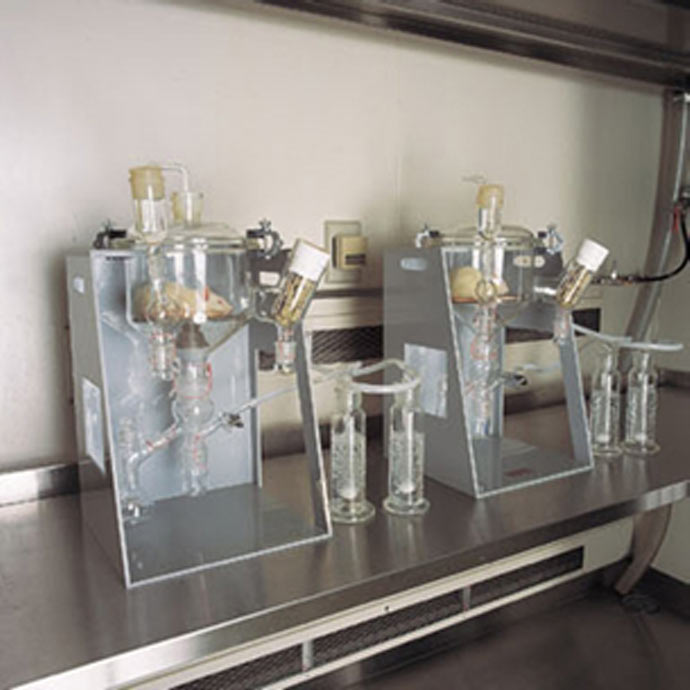In vivo (studies using labeled compounds)
Absorption
We calculate the pharmacokinetic parameters based on total plasma radioactivity concentration, unchanged drug concentration and its metabolite concentrations in samples obtained through multiple blood collections over time from an identical animal (feasible in various animal species). Then, the absorption rate, linearity, bioavailability and gender difference can be discussed in combination with the excretion study results. We will examine the absorption site as required.
Plasma drug concentration
We calculate peak plasma concentration (Cmax), time to peak plasma concentration (Tmax) and area under the concentration-versus-time curve (AUC). Then we evaluate the linearity of absorption, absorption rate, first-pass effect, extent of absorption and bioavailability through comparison of various parameters using intravenous administration or an administration route in which the absorption process is negligible.
Pharmacokinetic parameters can be analyzed using WinNonlin.
Absorption site
We examine absorption sites using the gastrointestinal loop method.
Distribution
We examine the distribution of a drug and its metabolites into various tissues, the changes over time, the remaining drug level and plasma protein binding rate.
Tissue concentration, distribution
We examine the ratios of various tissue concentrations to the plasma concentration at multiple time points including Tmax, 24 hours after administration and completion of the excretion, and the change over time. In tissues with a high level of remaining drug, the chemical status of the drug will be examined.
Wholebody autoradiography
We examine the whole image of drug distribution, its accumulation in the tissues, and the localization of radioactivity in the tissue. Localization of the radioactivity in microtissues, etc. can be clarified.
Plasma protein binding rate
We examine the plasma protein binding rate with plasma and purified protein from various animal species using the equilibrium dialysis method, ultrafiltration method or ultracentrifugal method.
Examination of drug partitioning into blood cells
We examine drug partitioning into blood cells using blood from various animal species (in vitro/in vivo).
Metabolism
We examine the metabolism profile using plasma, major tissues and excrement to see to what extent the drug is metabolized in an animal.
Establishment of metabolic analysis method
We establish the analysis methods using HPLC-RAD (Radioactive Detector) and/or High Resolution MS (LC-HRMS).
- Examinations
- Pretreatment method, extraction method, HPLC analysis condition, and enzymatic hydrolysis treatment
Transfer of metabolic analysis method
We confirm the reproducibility of the analysis based on your analysis conditions.
Metabolic analysis
We examine profile of unchanged drug and its metabolites in plasma, urine, bile and tissues, and their proportions.
Structural elucidation
Structural elucidation of metabolites will be performed using LC-HRMS.
Excretion
We determine excretion rates into urine, feces, expiration and bile, and examine excretion route, absorption rate and excretion speed of the unchanged drug and its metabolites. If the main excretion route involves bile, enterohepatic circulation will be examined as well.
Excretion in urine, feces and expired air
The measurement of the excretion is usually conducted until more than 95% of the dosed amount is excreted or up to 7 days post-dose. The residual radioactivity in the carcass will also be determined.
Excretion rate into bile
We examine the excretion route and absorption rate of drug.
Examination using the free-moving method is possible.
Enterohepatic circulation

If the main excretion route involves bile, enterohepatic circulation will be examined.
Examination using a tandem method is possible.
Pharmacokinetic study using chimeric mice with humanized liver
Chimeric mice with humanized livers (PXB-mouse®) can be used to study pharmacokinetics of a drug candidate to search for human-specific metabolites.
PXB-mouse® is a registered trademark of PhoenixBio Japan
Study for transfer of a compound into placenta/fetus and its excretion in milk
We conduct/examine the transfer of a candidate compound into the fetus during the period of organogenesis or the perinatal period in pregnant rats following administration by various routes (oral, intravenous, subcutaneous, transdermal, etc.), based on tissue distribution (tissue concentration and wholebody autoradiography). We have studied excretion in milk of a candidate compound in lactating rats following administration by various routes (oral, intravenous, subcutaneous, transdermal, etc.).
Repeated dose study
We examine the accumulation and retention of a candidate compound through the determination of plasma and tissue concentrations, examination of excretion into urine, feces and expiration and wholebody autoradiography in animals (rat, dog, monkey and rabbit) following administration by various route (oral, intravenous, subcutaneous, transdermal, instillation, etc.).